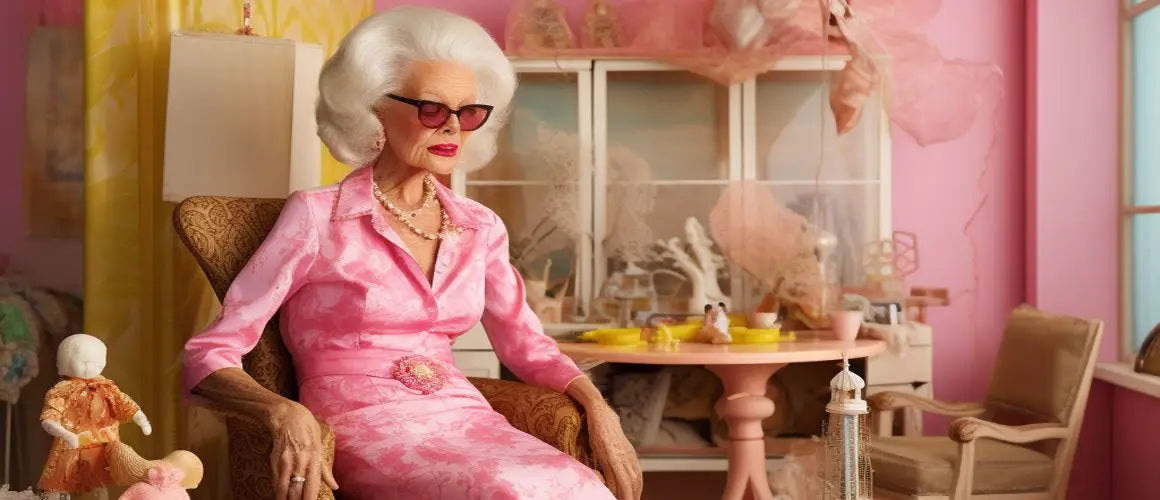As the highly anticipated Barbie movie hits screens this summer, AI-generated images reveal what Barbie would really look like in real life, aged 83 and with dementia, episodic mobility and chronic foot pain from decades of over-wearing heels.
While many think of Barbie as a never-aging 19-year-old, fans might be surprised to learn that Barbie – or Barbara Millicent Roberts - is actually aged 83 in real terms, having made her debut in 1959 at toy stores aged 19.
Developed to highlight the challenges around aging in today's modern world, the AI generated artwork has been created using Midjourney by elderly lifestyle experts at TakingCare Personal Alarms in a bid to normalise common signs of aging.
Click the links below to view the artwork.
- What would a more realistic doll look like, aged 83 years old?
- Barbie experiencing chronic foot pain from high heels, frailty and cataracts
- Barbie experiencing loneliness and grief
- Barbie experiencing dementia
What could a more realistic ‘Barbie' doll look like, aged 83 years old?

Image source: Midjourney
AI technology was used to explore what a more realistic version of Barbie could look like, based on the character being 83 years old in 2023.
The image highlights common signs of aging:
- Wrinkling round the eyes
- Shallowing of the cheek tissue
- Wrinkles forming above the eyebrows
- Skin changing on the neck area
- Greying hair
- Thin limbs that look frail
Whilst this representation shows common surface-level signs of aging, it gives an example of how the subject of aging can be explored and normalised in popular culture.
‘Barbie in the living room’ - frailty, cataracts and a high falls risk
In this image, Barbie is depicted as a frail older woman reclining on her favourite armchair.

Image source: Midjourney
She is barefoot, being no longer able to wear her favourite shoes after decades of overwearing heels has damaged her feet. Remnants of her former lifestyle litter her living room, as in her old age, Barbie struggles to keep on top of the housework.
Chronic foot pain from wearing heels daily for decades
Barbie’s penchant for high heels has left her with lasting health complications. Wearing heels daily has caused her to develop plantar fasciitis, which causes inflammation in the foot and sharp, shooting pain in the heel. Overwearing heels has also caused her leg muscles to tighten, adding extra pressure to her lower back and causing her to develop a slight hunched posture.
Wearing sunglasses indoors due to cataracts and deteriorating eyesight
Driving around in her iconic pink Beetle car is an image many think of when reminiscing about Barbie – but in this depiction, old age has contributed towards Barbie’s poor eyesight, and she can no longer drive. The 83-year-old has also developed cataracts – a condition that causes sensitivity to light and has resulted in her wearing sunglasses indoors.
Frailty due to age
At 83 years old and based on statistics, Barbie will have experienced 5-6 falls over the past few years. Studies show that adults over 80 have a 1-in-2 chance of having at least one fall each year, meaning wearing her go-to high heels is no longer an option. Studies also reveal that 1-in-5 falls suffered by the over 80s result in hospital visits, so it’s highly likely that Barbie will have received hospital care.
How to prevent falls
Falls are one of the main reasons that older adults lose their independence. With some careful thought and preparation, however, falls can be prevented. Take our free Falls Risk Score assessment to understand your risk of a fall and the most suitable personal fall alarms for your needs.
‘Barbie in the bedroom’ – grief and loneliness
In this image, Barbie is depicted as very frail, gazing pensively out the window. She depicts loneliness and grief, having lost her lifelong partner Ken.

Image source: Midjourney
Grief and loneliness due to suffering the loss of her long-term partner, Ken
According to Age UK, 1.4 million older people suffer from loneliness each year – and in this depiction, Barbie is one of them. Loneliness has a significant impact on mental health and quality of life. After enjoying a rich life of parties, socialising and multiple careers, Barbie now faces retirement and life as an older adult alone – something that many older adults struggle to adjust to.
Barbie is also depicted experiencing grief. Whilst Ken, her life-long lover, is two years younger than her, the average life expectancy of a man in the US is 77 years old (and 80 in the UK), so it is highly likely that Barbie will have experienced the tragic loss of the love of her life by the time she celebrates her 83rd birthday.
Barbie also never had children. A report by TakingCare reveals that daughters are the number one choice for taking on care responsibilities for elderly parents, with 1 in 3 adults giving up work to care for their frail parents. However, as Barbie has no children to care for her in her old age, she will likely have care plan in place from her local authority.
Recognising the signs of loneliness
Download our Staying Connected guide to recognise the signs of loneliness in older adults and to support you with practical solutions.
‘Barbie in the dining room’ - living with dementia
In this image, Barbie is depicted as an older woman with signs of dementia at the dining table.

Image source: Midjourney
Loss of facial expression and staring due to dementia
A lot of people look for memory issues when checking for signs of dementia, but here Barbie is experiencing an often overlooked sign of dementia. Vascular dementia is caused by reduced blood supply to the brain due to diseased blood vessels. This type of dementia causes a loss of facial expressions. People with this type of dementia may seem to stare a lot and not react visually to conversational cues due to blood vessel damage. Here, Barbie stares at the viewer with a vacant expression, as if struggling to keep conversation.
Fidgeting and wringing hands due to dementia
Whilst Barbie may seem poised in this representation, behaviourally she expresses further signs of dementia. In this image, Barbie can be seen wringing her hands and fidgeting. This type of restlessness is a dementia symptom that many people suffer with at later stages of dementia. Often, people will pull at their clothes or pace up and down, which can be due to pain or discomfort, need for more physical activity or problems with their environment.
Dementia is a term used for a number of symptoms associated with brain damage caused by disease. People experience dementia in different ways depending on the part of the brain that the disease has damaged. Dementia causes life altering changes, such as memory loss, personality changes and difficulty reasoning and problem solving.
Recognising the signs of dementia
For more advice on dementia, check out this guide to the early signs of dementia, or visit the Alzheimer’s Association website.
Commenting on the artwork, Claire Baker, Elderly Care Expert at TakingCare Personal Alarms said:
“Barbie has been at the centre of the conversation about women’s bodies and beauty since 1959, with the doll’s appearance evolving throughout her 60 year history. However, we are yet to see Barbie as she grows older, demonstrating how aging can change how our bodies look; ultimately, it’s something we all go through.
Barbie has often been identified as a divisive role model for female beauty standards, and in more recent years has taken a stance on highlighting more diverse body types - so why can’t she represent ageing?
Claire Baker
TakingCare Personal Alarms
“At 83 years old in real terms, Barbie will have certainly felt the signs of aging. She is in the prime age demographic for experiencing the effects of frailty, including falls – with one in two adults aged over 80 experiencing a fall each year – as well as being high risk for health conditions such as Alzheimer's, dementia and cataracts.
What would fairy tale princesses look like as they age?
We all know what the classic fairy tale princesses look like, but have you ever wondered how they would look when they start to get older?
“We know from our own reports that taboos around the aging process ultimately prevent people from properly making plans for their future lifestyle, which has an impact on the quality of care and support individuals receive in later life.
Let’s normalise the conversation around ageing. We all get older, and it’s nothing to fear. If Barbie embraced aging, I think a lot of the public would too.”
Supporting independence and healthy ageing
As we get older, we should be able to continue doing the things we love and living life the way we want to.
TakingCare's range of personal alarms and resources and advice support older adults and their families.



